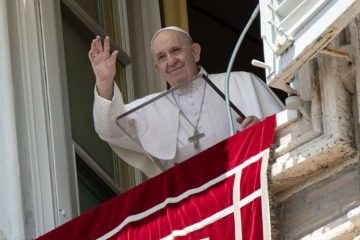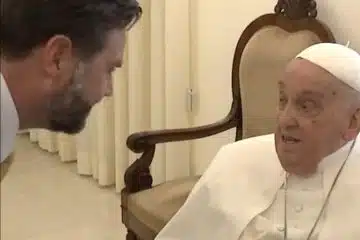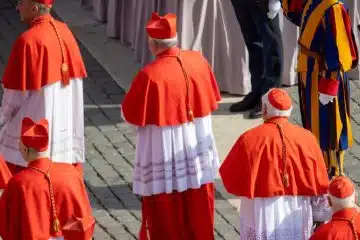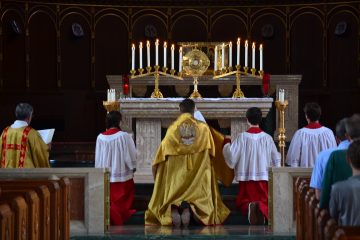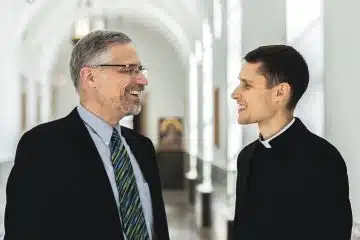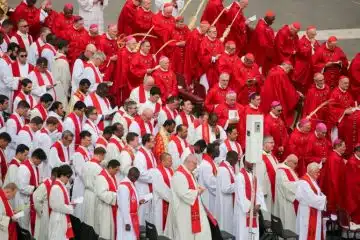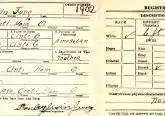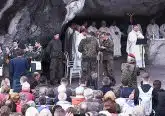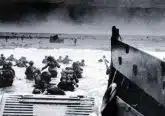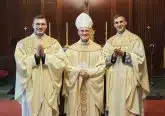Priests who join military as chaplains ‘answering a call within a call’
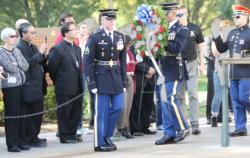
By Julie Asher Catholic News Service
WASHINGTON — Father Ben Garrett said he has “never felt more useful in my life” as a priest than as a Navy chaplain meeting the pastoral and sacramental needs of service members.
“Being a priest in the military is extremely fulfilling,” he said. “Not only is it a need for our people, but it’s also a great blessing for the priest himself.
“Our men and women in uniform take on great sacrifices on behalf of our country, and they need to be taken care of spiritually,” he told Catholic News Service.
Father Garrett, who was ordained for the Washington Archdiocese in 2006 and joined the U.S. Navy in 2009, was one of the military chaplains who gave their perspective on “serving those who serve” for a group of priests 10 priests who came from around the country for an Oct. 5-8 retreat aimed at helping them discern if they have a call to the military chaplaincy.
Sponsored by the U.S. Archdiocese for the Military Services, the retreat included an overview of the archdiocese, a look at life in the five branches of the U.S. armed forces through chaplains’ presentations and remarks by military officers, as well as visits to several military installations, including the U.S. Naval Academy in Annapolis, Maryland; the Air Force’s Joint Base Andrews, just outside Washington in Maryland; and Arlington Cemetery, the Pentagon and the Army’s Fort Myer post, all of which are in Arlington, Virginia, just across the Potomac from Washington.
The retreatants ranged in age 30 to 45 and came from dioceses in New Jersey, Arizona, Ohio, Georgia, Texas, Florida and Illinois.
“Answering a call within a call” and “serving those who serve” were two common themes running through their time together.
“I know very well there is a need for priests worldwide. Like the military says, ‘low density, high demand.’ There’s no bishop in the country who cannot make an appeal for more priests,” Archbishop Timothy P. Broglio of the U.S. Archdiocese for the Military Services told the group Oct. 6 at archdiocesan headquarters.
But the need for Catholic military chaplains is critical, he said.
Catholics make up one-fourth of the military population and priests account for just 8 percent of the chaplain corps.
Over the past 14 years, the number of active-duty Catholic chaplains has fallen from over 400 priests to 228. There is only one priest for every 1,300 Catholics in the U.S. military.
“I can do no more than facilitate” the opportunity to learn about the chaplaincy, the archbishop told the group. Ultimately, the priests would have to “listen to the voice of the Lord” to discern if they have “a call with in a call” and to discuss it with their bishop, but he said he hoped the week would give them an understanding of the military archdiocese and the 1.8 million Catholics it serves.
A priest can only be considered for the chaplain corps after three to five years of pastoral service in his diocese or religious order; he also must get permission from his bishop or religious superior to sign up. Chaplains in the armed forces are essentially “on loan” to the U.S. military archdiocese, based in Washington. In general, they commit to a five-year stint and can re-enlist.
Priests also must meet certain qualifications of the military, such as being physically fit and able pass a medical exam in order to deploy with the troops if need be. According to military rules, they also must be “under a certain age,” which varies depending on the branch.
Besides providing spiritual, pastoral and sacramental care to Catholic military personnel on active duty and their families in all five branches of the military, as well as those in the reserves and National Guard, the archdiocese provides pastoral care for Catholic patients in 153 Veterans Affairs hospitals and Catholics in government service overseas in 134 countries, such as diplomats and contractors.
“There are needs that must be met as long as we have troops. My hope is that this will be a time of prayer and information, but most important is to listen to the voice of the Lord and see where it is he is leading you to on your path of service in the church,” Archbishop Broglio told the group.
In his remarks to the group, Father Garrett encouraged the priests “to keep an open heart, an open mind” about the chaplaincy, and not be afraid to look into it with their superiors or with their bishop. He also wanted them “just also know they’re greatly needed.”
A Navy lieutenant, Father Garrett is currently a chaplain recruiter at the Navy Officer Recruiting Station in Hyattsville, Maryland. Previously, he served as chaplain on an aircraft carrier, at the Marines’ Camp Pendleton and in Afghanistan.
Unlike a parish priest, military chaplains are “with our people” 24/7, he told CNS later.
“We live with them, we eat with them, we share the same facilities with them, we keep the same schedule, we run with them, we work out with them, we deploy with them, we’re with them all the time — much more than in a parish setting, and there’s something very beautiful about that.”
When sailors are deployed overseas on ships and there’s no priest with them, “they go without the sacraments, without confession, without the Eucharist for six, seven, eight, nine months,” Father Garrett said. “You know, it’s not a matter of just being creative with the Mass schedule or traveling a greater distance to a different parish — there are no options. It’s very hard for us to maintain our spiritual life in a void, it’s hard to maintain our spiritual life if we’re not being fed especially sacramentally.”
His remark about feeling so fulfilled in his priesthood as a military chaplain resonated with Father Fernando Lopez, a priest of the Diocese of Trenton, New Jersey, and administrator at Our Lady of Perpetual Help-St. Agnes Parish in Atlantic Highlands.
“Father Ben said something that is going to be with me the whole week — ‘I never felt more useful in my priesthood than being in the military,'” Father Lopez, 40, told CNS. “He’s doesn’t mean as parish priest you are not being useful, but he can see how he can put his talents, his ministry and all his training in the seminary, how he can put everything for the guys serving in the military.”
Father Lopez, like the other priests at the retreat, came because he already had an interest in the military. The archdiocese also had more applicants than retreat spots.
“Since I was a kid, I wanted to serve in the Army,” said the Colombian-born priest. Then he entered the seminary because he wanted to serve as a priest. Ordained in 2011 for Trenton, the chance to be a priest in the military is “like a dream coming true,” he said. “I want to pursue that dream.”
After touring the chapel at the Naval Academy and hearing from several Navy officers about the chaplain’s role in their own military service and family life, Father Grzegorz Wojcik, 34, a priest of the Chicago Archdiocese, found it “very moving” to hear from the officers’ testimony and to be surrounded by history at the academy.
The associate pastor at St. Eugene Parish in Chicago said he will be seriously considering the chance to serve “those who serve us, who protect us” in this country.
Posted October 12, 2015


